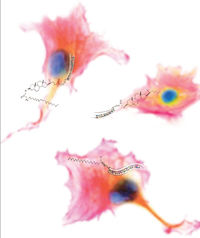Amsterdam Molecular Therapeutics Successfully Lowers Cholesterol In Vivo with Enhanced Novel MicroRNA AAV Gene Therapy
Advertisement
Amsterdam Molecular Therapeutics (AMT) Holding N.V. announced that its gene therapy product incorporating siRNA sequences into microRNA scaffolds to silence Apolipoprotein B100 (AAV-miApoB) was able to significantly lower plasma cholesterol levels in vivo over a period of 18 weeks. These preliminary results suggest that this approach could lead to a treatment for high cholesterol in humans.
Using its proprietary adeno-associated viral vectors (AAV), a single injection of AAV-miApoB transduced murine hepatocytes almost entirely and resulted in a reduction of total plasma cholesterol of 60-80% for an 18 week period. AAV delivery of miRNA, expressed from a liver-specific promoter, constitutes the second powerful approach by which AMT has demonstrated to lower plasma cholesterol, together with AMT’s AAV shApoB gene therapy product tested in the same model of the disease. In our new approach, we went one step further and limited the expression of the inhibitory miApoB molecule only to the hepatocytes, which provides a higher safety profile, a feature very important for future clinical applications. Data were presented at the Hepatocyte User Group and Medicon Valley Hepatocyte User Forum in Montpellier, France, and at the European Society for Gene and Cell Therapy Annual Conference in Milan, Italy.
In the new study, mice received intra-venous injections with equal doses of 1011 gc per animal AAV-shApoB or AAV-miApoB and were examined for 18 weeks. Expression of the shApoB and miApoB resulted in 90% ApoB protein knock-down, associated with 80% cholesterol decrease in murine plasma for the first 6 weeks. However, after 8 weeks the effect of the shApoB started to wear off, while miApoB remained effective in ApoB and cholesterol reduction for up to 18 weeks. Ongoing research aims to determine the mechanism for the differences seen between long-term AAV-shApoB and AAV-miApoB efficacy in murine livers. AMT believes that the long-term stability of the miApoB is due to its lower toxicity and off-target properties compared to shApoB because expression of miApoB is specifically limited to hepatocytes.
ApoB100 is the structural protein of Low Density Lipoprotein (LDL) particles that carry cholesterol. Silencing the activity of ApoB100 with miRNA or shRNA lowers plasma LDL-cholesterol by 60-80% and has the potential to be used to treat hypercholesterolemia and associated cardiovascular disease.
Other news from the department research and development
Most read news
More news from our other portals
See the theme worlds for related content
Topic world Gene therapy
Genetic diseases once considered untreatable are now at the center of innovative therapeutic approaches. Research and development of gene therapies in biotech and pharma aim to directly correct or replace defective or missing genes to combat disease at the molecular level. This revolutionary approach promises not only to treat symptoms, but to eliminate the cause of the disease itself.

Topic world Gene therapy
Genetic diseases once considered untreatable are now at the center of innovative therapeutic approaches. Research and development of gene therapies in biotech and pharma aim to directly correct or replace defective or missing genes to combat disease at the molecular level. This revolutionary approach promises not only to treat symptoms, but to eliminate the cause of the disease itself.























































